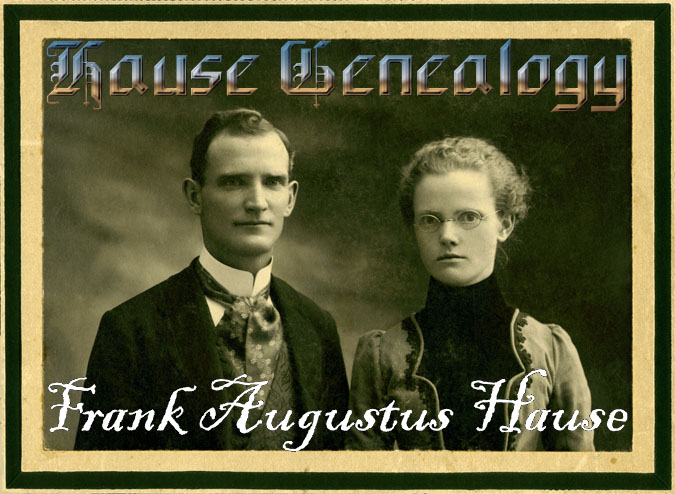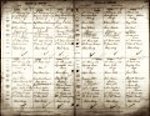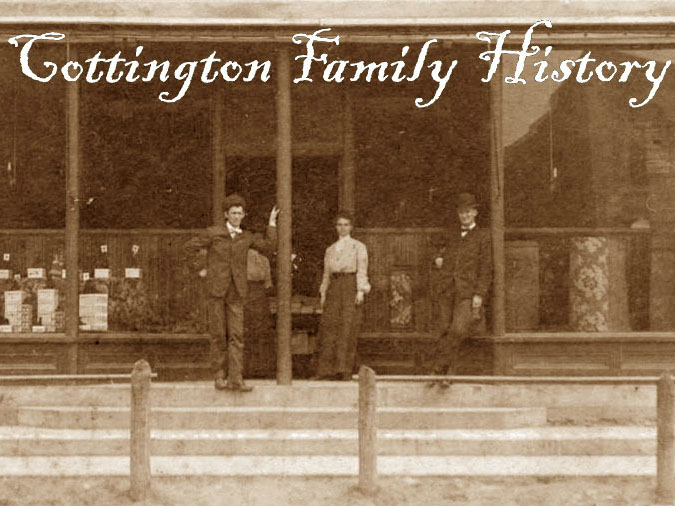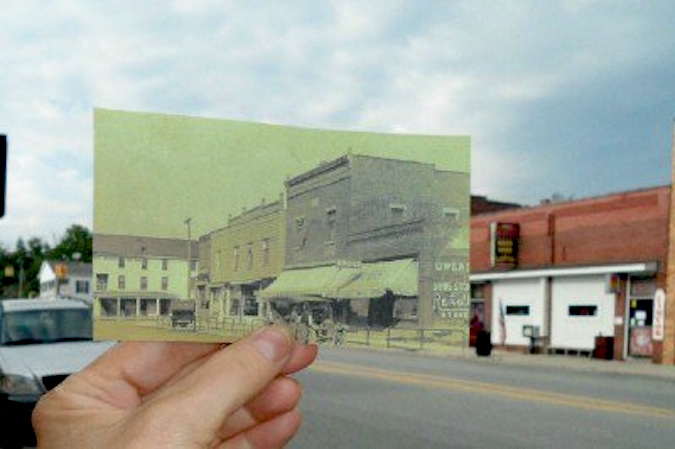|
"If my Father wants beer, cheese and crackers on his deathbed, then by God, he's going to have beer, cheese and crackers."
—Carlisle Hause, fulfilling Frank Hause's last wishes, 1951.
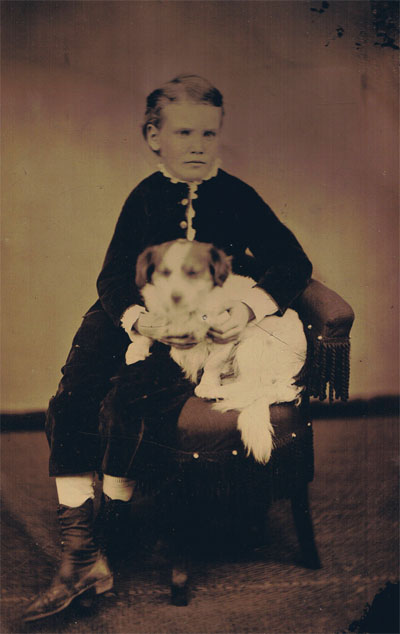
A tin-type of Frank Hause. (Courtesy of Jerry Hause.) |
|
Laban and Melissa's son, FRANK AUGUSTUS HAUSE (4/14/1867 - 5/3/1951), is the guy from our family who everybody had a story about: Legends abound, and they're all pretty funny. Although young Frank looks very serious while holding the puppy at right (what was he doing, trying to strangle the thing?), those who knew him say he was actually a fun-loving man, who in family lore burned through two fortunes and a number of businesses (which was probably exaggerated), and as his very last wish, demanded beer, cheese and crackers on his deathbed (which was verified by several sources as true). He was a farmer, store owner, auctioneer, salesman, hat maker, boarding house owner, the clerk and treasurer of Riley Township, the Village President of Memphis (as well as clerk, trustee, and assessor), a member of the Board of Education, and a Mason, yet some people say he was sort of a slacker!
Frank never really followed his father's tastes. While Laban was in Millington, Frank returned to Riley Center and worked for his uncle, Ed Sanderson (1831-1907). When Laban built the brick farmhouse, Frank carried bricks for his father to build the estate—but even then he refused to work on his father's farm, and stayed with his job at Uncle Ed's. (He did, however, become very involved in the local Masons Lodge with his father. Frank signed on as a "Master Mason" on September 19, 1900.)
Frank inherited his father's intensity (compare Frank's eyes with those of Laban) and his mother's sense of style. A born salesman, Frank had a certain swagger—he would be the perfect man to lead the Hauses into the 1900's. But he couldn't have done it without the help of an amazing woman:
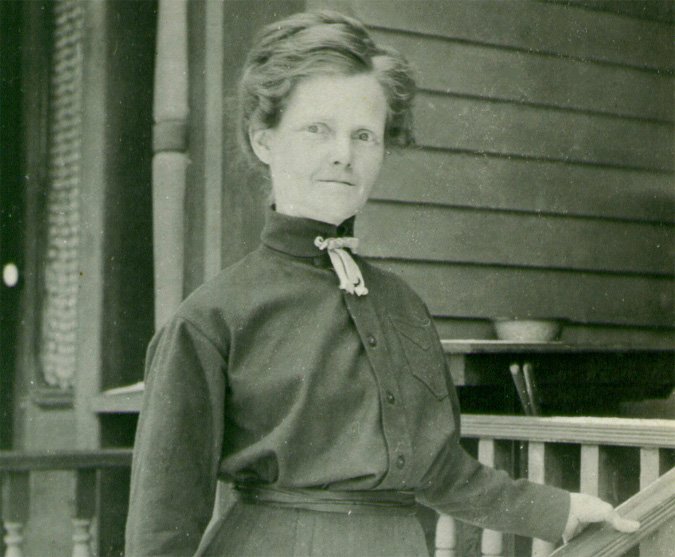 |
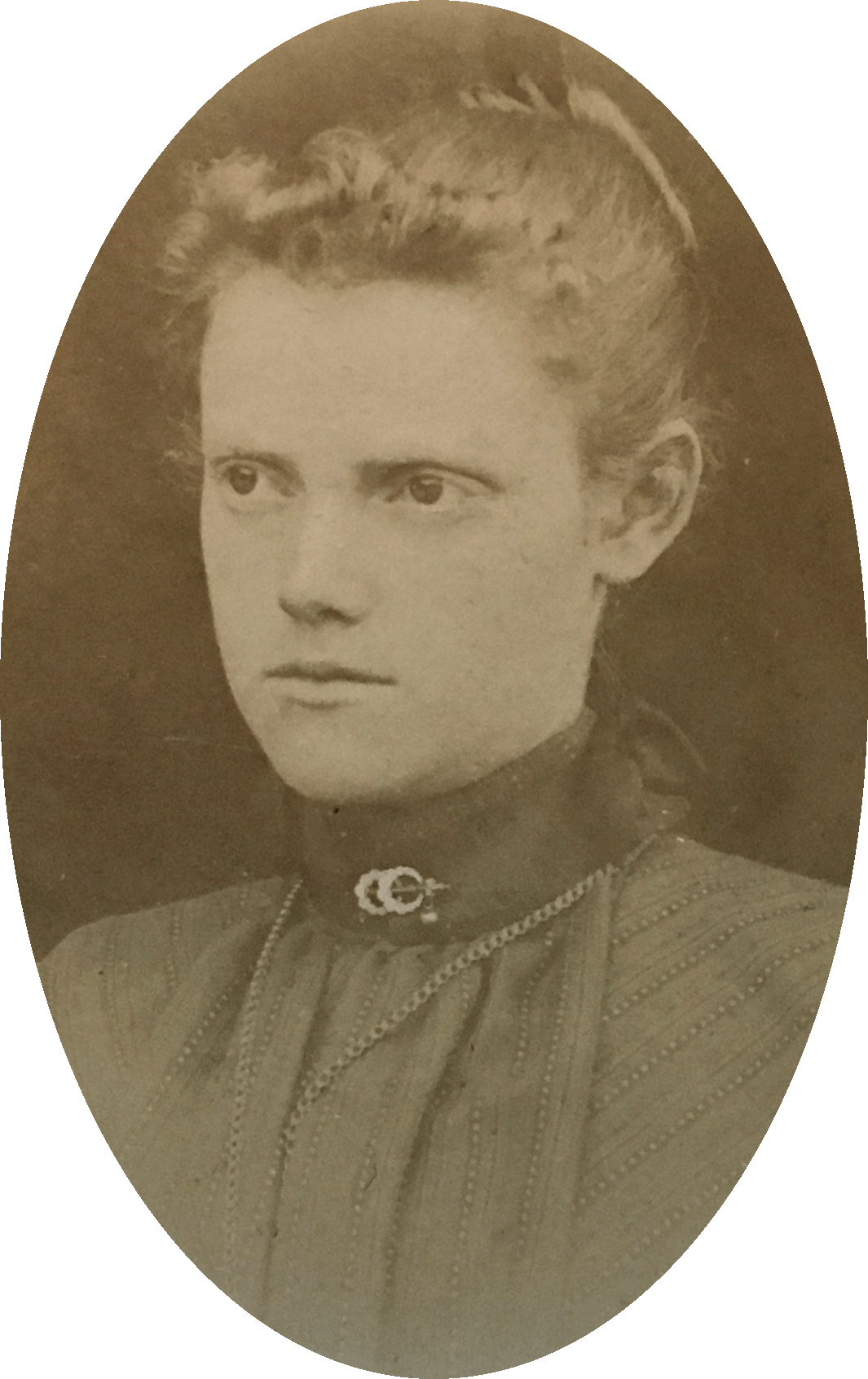
|
On February 18, 1888, Frank married FLADELLA RAYMOND (11/6/1869 - 7/19/1961). They were wed in the home of the bride's parents in Port Huron. According to the literacy-challenged St. Clair County records, they were married on "18 Feb 1888, in Fort Gratiot: Frank A. House, 20, W, r/b Riley, Farmer, P: Labian House and Malissa Sanderson; Della Raymond, 18, W, Port Huron, b. Capac, P: A.J. Raymond & Matilda Kilbourne; Geo. Johnson & Hattie Davis, both of Port Huron; G.C. Jennings, Min."
Fladella's parents were also remarkable people. Her father, Albert, was in the Union battalion that captured Jefferson Davis at the close of the Civil War. He was a blacksmith (which makes you wonder if he knew the ancestor of his new son-in-law was the great silversmith Robert Sanderson), and also worked in the Port Huron customs office. But eventually they moved near the Hause family in Riley Center.
Fladella was something of a warrior herself, who fought to protect and improve her family's fortunes throughout her long life. Fladella's son, Basil, remembered her as a creative person who was very interested in education and culture. Although she had only been educated through the second year of high school (and Frank only through the eighth grade), she teamed with Melissa to run a boarding house in Ypsilanti, so that her sons would have the money and lodging to be educated at a nearby college, in order to make sure that the next generation of Hauses would have opportunities that their ancestors were denied.
|
| Personal Data |
Wedding Record |
|
| Groom: |
|
Frank A Hause |
| Spouse: |
|
Della Raymond |
| Date: |
|
18 Feb 1888 |
| Marriage Place: |
|
Fort Gratiot, St Clair, Michigan |
|
|
|
|
SOURCE INFORMATION: Michigan Department of Community Health, Division for Vital Records and Health Statistics.
|
Laban was elated over the engagement of his only son. Around 1888, he built a fine brick house across from his farm property for Frank and Fladella. But much to Laban's disappointment, the newlyweds instead moved into an old log cabin—actually a sheep barn—on the Raymond property, which Fladella's father had converted into a home. They immediately started a family, and produced the three sons that would carry the Hause family into the Twentieth Century.
Here are the children of Frank and Fladella Hause:
CHILDREN OF FRANK AUGUSTUS HAUSE AND DELLA RAYMOND |
|
RAYMOND "DICK" LABAN HAUSE was born on 23 Nov 1888. He married a nurse, Ethel Maud Yale (1 Feb 1886 - 19 Jan 1988), in Michigan in 1911. They had one child, Lois Yale Hause, born on 7 Oct 1913. "Uncle Dick" moved his family to California and worked in land speculation. He died on 12 Nov 1970 in San Diego, California. Many of his photos and keepsakes, handed down to his daughter, are used in this family history.
|
|
CARLISLE HAUSE (no middle name) was born in 5 April 1891. He became a schoolteacher and fell in love with MARJORIE E. MARCHANT. She was a maid's daughter, who moved to Minnesota to be with her sister when her mother was killed by a car. But Carlisle tracked her down and brought her to Michigan as his bride. Marjorie died in 1938, and he remarried, to a fellow schoolteacher named EMILY MEISTER and moved to Bloomfield, Oakland, Michigan. Carlisle died on 23 Mar 1972 in Pontiac, Oakland, Michigan. He is buried at the Memphis Cemetery in Memphis, Macomb, Michigan.
|
|
BASIL FRANKLIN HAUSE was born on 4 Nov 1895. While he was young, he worked in his grandpa Raymond's blacksmith shop. He married Hazel May Gilmartin in 1920. Basil and Hazel had two children: Gerald Franklin in 1926 (our family historian), and Barbara Joan in 1928. Many of Basil's family photos, and his recollections (recorded by his son, Jerry) form the basis for the Michigan chapters in this family history. Basil died on 7 Dec 1985 in Royal Oak, Oakland, Michigan.
|
|
FREDERICK CLINTON HAUSE was born in 1900, but died from an undisclosed illness while still an infant, on 24 Sep 1901 in Memphis, St Clair, Michigan. There are no known photographs that were made of Frederick before his death. He is buried at the Memphis Cemetery in Memphis, Macomb County, Michigan.
|
|
MAURICE CALVERT HAUSE (pronounced "Morris") was born on 5 April 1910. "This laughing baby is the youngest son of Mr. and Mrs. Frank A. Hause, Memphis, Mich . . . He was one year and four months when this picture was taken." Maurice died when he was 16 years old. "Funeral services, conducted by Rev. S.H. Townsend, were held at 2 p.m. Monday for Maurice Hause, 15, who died Friday night after a short illness. He was a junior at the high school, also a member of the Young Men's club and the high school orchestra, the village band, the football and basket ball teams."
|
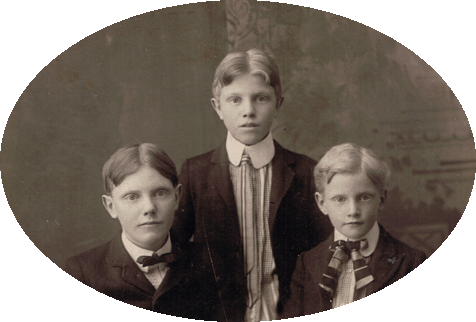
|
Left-to-right: Raymond, Carlisle and Basil Hause.
|
|
Raymond, Carlisle and Basil Hause were so close that they nicknamed themselves "Tom," "Dick" and "Harry"—but only the "Dick" moniker stuck permanently, as the family's nickname for Ray. The family rented the Joseph Sage home on Belle River Road, where the children were raised strictly—when they visited grandpa Laban and grandma Melissa on Sundays, they had to wear their finest church clothes, sitting for hours with barely a twitch for fear of wrinkling them, before leaving by horse and buggy from Memphis to their grandparents' red brick estate in Riley Center. But occasionally they would skirt the rules, rebelling against authority like characters out of a Mark Twain novel: When ordered by the departing Fladella to do the dishes, they soaked them outside the home in Sage creek instead of washing them properly—which would've been a nice solution if they hadn't quickly lost interest and forgotten to take the dishes back out of the creek. After the few remaining dishes still left in the creek's raging current were retrieved, you can be sure beatings were in order. They were pranksters and adventurers. They were born salesmen like Frank, but with Fladella's work ethic and iron will.
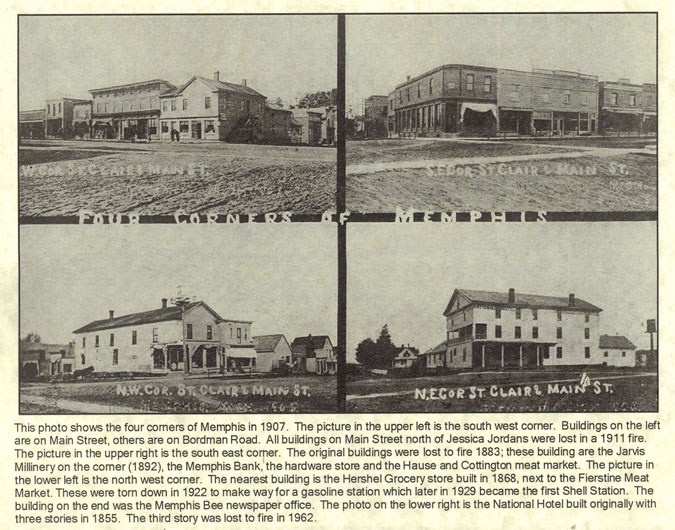 |
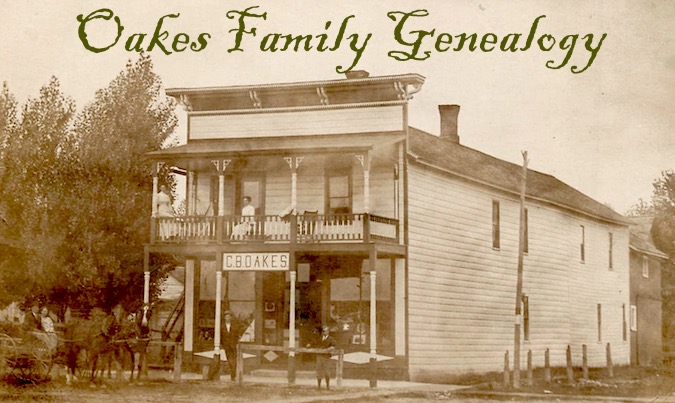 |
After years of dissent and rebellion, Frank was finally following in his father's footsteps—he farmed the family land, and ran a general store in Riley Center, as well. Frank originally went into partnership at the store with Charles Bimey Oakes (son of Frank's aunt, Basheba) at 1539 Riley Center Road. (Laban had run the first store in Riley Center, built by Martin Ellinwood.) Later, Frank and C.B. engaged in mercantile business in Memphis, erecting the building occupied by A. J. Pearsall (1938). Frank was even the Riley township treasurer and clerk.
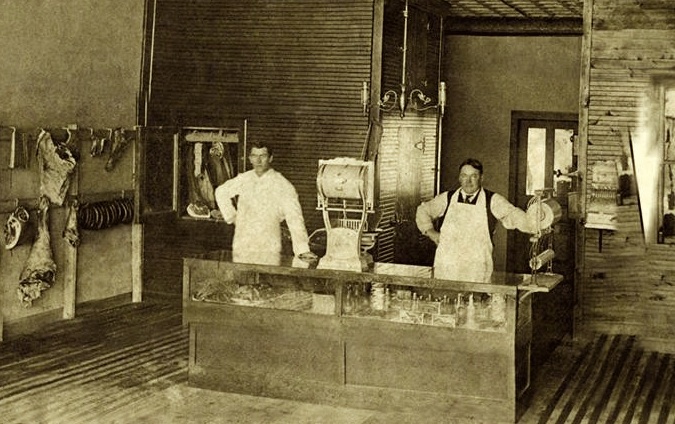
In 1907, George Cottington (left) and Frank Hause opened a meat market on the east side of Main Street. (This building became the Memphis Drug Store.) The room in the rear-left is the meat storage room, which was filled with blocks of ice to keep the meat cold and has a small door/window to show off the meat. Larger pieces are hung on the wall to be inspected by the customers. The cash register is still on display in the store today, and the scales are owned by Frank's grandson, Jerry Hause. (Photo coutesy of George's grandson, Larry Cottington, and the Memphis Historical Society.) |

|
When Oakes withdrew from the partnership, Frank and Fladela moved to Memphis, where he opened another store in 1898. Frank called this store the "Frank A. Hause General Merchandise Goods Groceries & Crockery"—then joined in business with his brother-in-law, George Cottington, the husband of Edith Hause. They started out in a simple wooden shop, but in 1907 they moved into a larger, two-story brick building, at 80850 Main Street. They first used it as a meat market, which eventually turned into the "Hause-Cottington Store."
In early Twentieth Century Michigan, general stores usually sold a wide range of goods—from food, clothing, and housewares to farm equipment. When money was scarce, the storekeeper might extend credit to regular customers or accept payment in kind, a practice known as "bartering." In rural communities like Memphis, the general store also served as a meeting place and source of local news. (See a calendar from the store here.) Edith Hause (pictured at right) was by all accounts a great beauty, and probably enlarged the store's male clientele by a great number.

At left, Frank, George, Edith & Fladella in front of the store; At right, a hundred years later.
 |
Frank's store is still there today in Memphis, under a different name, with the same frame, clientele and even the same ceiling (see photos, above, for the store in 1902 compared to today).¹
At this time, the Sage house that Frank was renting was purchased by the Taylor family, so Frank and his family moved into the apartment over the store. Frank and Fladella's apartment was on the second floor. It was accessible by stairs on the left side of the building. The Hause family lived in the back rooms, with the local dentist, Dr. McVicker, working in the two front rooms. (You can see the "DENTIST" sign in the window of the above photograph, which would've made for a loud household when he was pulling teeth.)
STORE GOODS IN THE LATE 19th CENTURY: |
|
Transport of grocery items from any distance was more expensive than the items themselves, so most of the merchandise was produced locally, or by the storekeepers (witness "Hause and Cottington Royal Tea, Ex-Fancy," at right).
Sugar cost 4¢ a pound; Eggs were 14¢ per dozen; Coffee was 15¢ a pound; Spring chicken was 7¢ per pound.
The ice cream cone made its debut on April 30, 1900.
Marijuana, heroin, cocaine and morphine were all available over the counter at corner drugstores. According to one pharmacist, "Heroin clears the complexion, gives buoyancy to the mind, regulates the stomach and bowels, and is, in fact, a perfect guardian of health."
Asthma cigarettes were recommended by doctors as a convenient way of administering drugs directly to the lungs: "Joy's Cigarettes afford immediate relief in cases of asthma, wheezing, and winter cough, and a little perseverence will effect a permanent cure. Universally recommended by the most eminent physicians and medical authors," according to an ad for Joy's Cigarettes.
In 1886, Atlanta pharmacist John Pemberton stirred up a fragrant, caramel-colored liquid made from caffeine citrate, citric acid, vanilla extract, lime juice, sugar, caramel sufficient, and powder extract of cocaine. He carried it a few doors down to Jacobs' Pharmacy. It was mixed with carbonated water and offered to customers in free samples. It proved so popular that the pharmacy began charging five cents a glass, and named the new drink Coca Cola.
Coca Cola was launched as a product in 1886, and offered free to customers in order to create a demand. After demand for the drink had reached the level of "craze," the price was raised to a nickel.
In 1899, Chattanooga lawyers Benjamin F. Thomas and Joseph B. Whitehead secured the exclusive rights to bottle and sell Coca Cola, for the grand sum of... one dollar.
|
|
|
| Personal Information |
Postmasters |
|
| Name: |
|
Frank A Hause |
| Post Office Location: |
|
Riley Centre, St Clair, Michigan |
| Appointment Date: |
|
18 Sep 1895 |
| Volume #: |
|
54 |
|
|
|
SOURCE INFORMATION: National Archives and Records Administration (NARA); Washington, D.C.; Record of Appointment of Postmasters, 1832-Sept. 30, 1971; Roll #62; Archive Publication #M841.
|
In 1900, Laban was also a delegate at the Republican Convention, according to the 10 Aug 1900 Yale Inquisitor. Following in his father's footsteps once more, Frank became very active in local politics—he served as both clerk and treasurer of Riley township (the April 08, 1892 Weekly Expositor newspaper in Yale noted that Frank was Riley's treasurer, while Laban was on the Board of Review), and even became the postmaster of Riley Center in 1895. He also served as president, clerk, trustee and assessor of Memphis village. He was even a member of the Memphis Board of Education (despite never attending high school, himself), which must have pleased Melissa to no end.
Frank was even active in the Mason's Lodge, like his dad (he apprenticed, earned his Fellowcraft Degree and his Master Mason Degree in 1900, then was made a lifetime member in 1940). Beyond that, he and Fladella would preside over the Hause clan in Memphis for the next forty years.
"Frank has been sick over a week with the Grip. He got better & went out too soon & is not well now. Your Ma has been down with the same complaint but is better—so she is up part of the time... Frank's little Carl is sick. I suppose it is the Grip. It is too bad... He is so young."
—Laban Hause, to his daughter, Elma Hause Jackson.
| Correspondence |
File Image |
| From: |
|
Laban Hause |
| To: |
|
Elma Hause Jackson |
| Subject: |
|
La Grippe (influenza) |
| Date: |
|
August, 1892 |
|
|
|
SOURCE INFORMATION: Scrapbook of Charles Hause Jackson.
|
|
Perhaps because of the Victorian Age he lived in, or the hard times he had overcome (or the extended length of time you had to pose for early cameras), Laban Hause seems to rarely display emotion in photographs. Occassionally, however, he would let his guard down—such as the hint of a smile in his wedding photo with Melissa, or in correspondence like the letter, at left, to his daughter in New Jersey as his family in Michigan suffered through an outbreak of "the Grip" (also spelled/written as Gripp or La Grippe in contemporary documents), a term used in the 19th century for deadly influenza. A pandemic began in the winter of 1889-90, with many areas reporting the first signs of a large-scale outbreak in March of 1891. The epidemic eventually hit 40% of the world's population.² In Michigan, deaths from the disease jumped from just two reported cases in 1888, to over a thousand in both 1890 and 1891. The epidemic continued through 1892, and reached the Hause family that August. Fortunately, Frank, Melissa and Carl survived the grips of the Grip, and by 1893, the number of deaths in Michigan fell to less than a third of the previous year's. Still, the pandemic continued in the form of local epidemics into the Twentieth Century, with the disease suddenly appearing in a community and, after a prevalence of about six weeks, disappearing again, but may have caused at least two deaths in the family in the early 1900s.
At the close of the Century, Laban retired from farming and moved into Memphis, while Frank and his family moved to an estate called the Bywater house (later the Vlasic Pickle factory). But there were bigger changes on the way. With the onset of the Twentieth Century, Michigan itself would change: The technological age would change the way people lived. Agriculture would no longer be the state's main industry, thanks to mass production and an influx of southern labor. Soon farms would be replaced by factories; and beyond that, there would also be the introduction of airplanes, telephones, movies, organized sports, psychotherapy, organized crime, and most importantly for Michigan, the automobile.
"I invented nothing new. I simply assembled the discoveries of other men behind whom were centuries of work. Had I worked fifty or ten or even five years before, I would have failed. So it is with every new thing."
—Henry Ford.
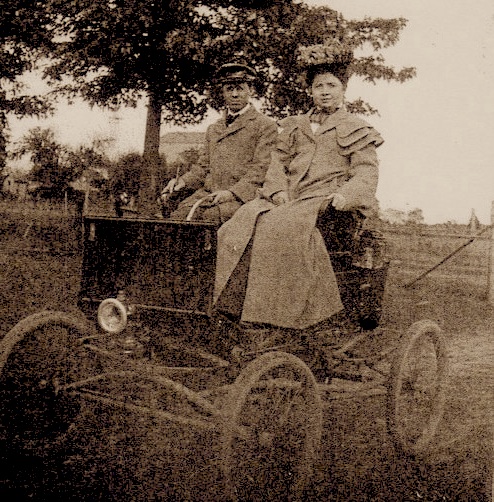
Clegg and wife on a Locomobile Runabout.⁵
|
The first recorded self-propelled vehicle in Michigan (and perhaps in the country) was built by Thomas Clegg and his English-born father, John, between 1884-85 at the John Clegg & Son Machine Shop in Memphis.³ At first, the machine was called "The Contraption," but Clegg finally settled on "The Thing." It turned out to be "the thing" that ate Michigan! Soon the first and finest automobiles in the United States were being built by men in the Great Lakes area—Henry Ford, Ransom Olds, Charles B. King and David Dunbar Buick all lived in Michigan.
But it was Henry Ford who come to dominate the industry. In 1908, he decided to focus his company's efforts on the construction of only one model—the "Model T." In order to help lower costs, he introduced assembly line production, and soon car manufacturing became the state's most important industry and source of employment.⁴ Frank himself bought his first car in May of 1912, according to the Port Huron Times Herald.
The next line of the Hause family changed with the times as well. No longer a line of farmers, they became educators, land speculators, and entrepreneurs. "Tom, Dick and Harry" were born salesmen like Frank, but with Fladella's work ethic and iron will, and they adjusted easily to modern society. But Frank's sons never forgot the family roots as they carried our family into the modern era of...


Frank and Fladella Hause.
|
CHAPTER 9: 20TH CENTURY MICHIGAN, 1900 - 1959: The Hauses enter the Twentieth Century with flare—as their store catches fire. Frank and Fladella's sons become the first college-educated generation and enter advertising, education, and industrial work, and the days of the Hauses farming open land on the frontier are over. Meanwhile, Frank and Fladella begat Carlisle, who begat Carleton Marchant Hause, Sr., who begat Carleton Marchant, Jr.
TITLE PHOTO: Frank Hause and Fladella Raymond on their wedding day.
NOTES FOR THIS PAGE:
¹—The store is still in operation today, but is now a chain drugstore: "Our store dates back to 1910 reflecting the culture and history of our beloved hometown. The store still preserves its 100 year old character in the 21st century. So no matter what your needs are you will find it here. So why don't you pass by for a visit to a historic store during your next visit to Memphis. Michigan? "Memphis Drugs operates at 80850 Main St., Memphis, MI 48041-4907, phone (810) 392-2424 with satellite locations throughout Michigan. However, from this satellite location and with our well organized delivery services we have the capacity to serve the entire State of Michigan. You may consider us your virtual pharmacy, always alert; always responsive, always there!" (Old Memphis Drugs website)
²—Cyrus Edson's "La Grippe and Its Treatment for General Readers," published in 1891, suggested people in "the grip" of the flu would be burdened by depression on top of physical symptoms and urged caregivers to combat such depression. Patients should take a laxative of castor oil or rhubarb pills at the beginning of the illness. Headache and muscle pain could be alleviated with phenacetin or salol. Hoffman's anodyne, which was anodyne, diaphoretic, diuretic, and a stimulant, was to be taken at 4 hour intervals while the patient was bedridden. He went on to suggest other mixtures and elixirs such as a grog made of 1 part wine to 3 parts water, cocoa wine (which contained cocaine), champagne or wine, and tonics of quinine, iron, and strychnine. (Yes, strichnyne.) A croup kettle with a tincture of benzoin should be used to help symptoms in the breathing passages, as would a rub with Chloroform liniment or camphor oil. An alcohol and salt massage could benefit a grippe patient with profuse sweating. Another interesting substance said to have helped people suffering from the grippe was opium, which was only to be given after a patient had been given a laxative, and the bowels had "recovered" from the laxative.
³—The John Clegg & Son Machine Shop was located at 35412 Bordman at the southeast corner of Bordman Road and Cedar Street in Memphis. "The Thing," driven by a single cylinder steam engine with a tubular boiler, seated four. Leather belts transferred the power to the 5'8" rear wheels. Soft coal was used for fuel. The Memphis Historical Society has the shop's cash register, and it contains receipts for transactions with the Hause family (pictured below).
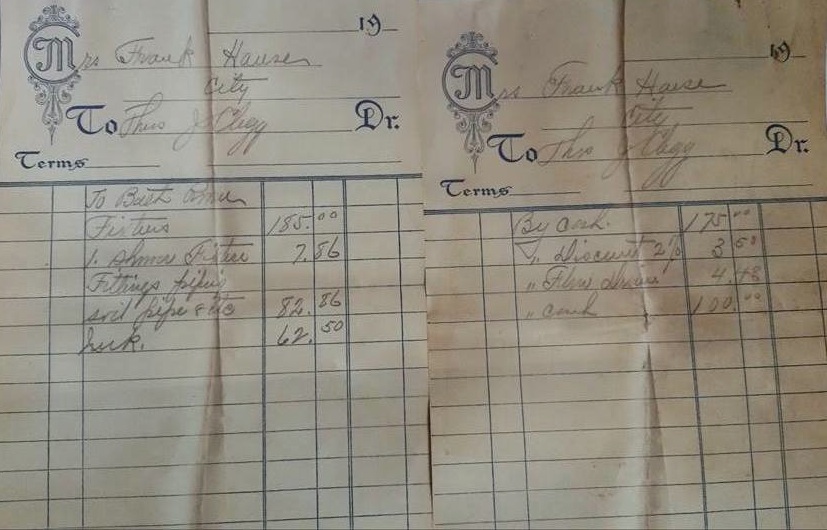
Hause/Clegg transactions (photo coutesy of the Memphis Historical Society). |
⁴—The Hause family wasn't involved in the Detroit auto industry until Frank's grandson, Gerald "Jerry" Hause, helped design the classic 1955 Chevy. I thought he knew a lot about genealogy, then I asked him about the Chevy. It's truly impressive how he can remember the smallest family anecdotes, but with the Chevy he can talk for hours about such small details as why, for instance, they moved the air conditioner buttons over 2 inches after some test drives, and it's very technical and over my head, but brilliant! I guess that's why the cars are still on the road, sixty years later, and why the car is such a valuable, classic automobile.
⁵—"The vehicle pictured is an 1899 Locomobile Runabout. I did extensive research on the Thing 6 years ago for an automotive history class in college. I have a direct quote from Thomas Clegg in a 1934 article from the Port Huron Times, where he states that there never was a photograph taken of either of the two prototypes he developed." (Message from Paul Kus)
LITERARY SOURCES FOR THIS PAGE: A Cultural History of the United States, The 1900s by Adam Woog. Published by Lucent Books, 1999.
Family history as recorded by Melissa Sanderson Hause (in possession of Jerry Hause).
St. Clair County, Michigan, its history and its people : a narrative account of its historical progress and its principal interests, by William Lee Jenks, 1912.
La Grippe and Its Treatment for General Readers, by Cyrus D. Edson. Appleton & Co., 1891.
Annual Report on the Registration of Births and Deaths, Marriages and Divorces in Michigan, Volume 25, by the Michigan Dept. of Health and Wynkoop Hallenbeck; Crawford Company, State Printers, 1892. P. 313.
Yale's Weekly Expositor, was published weekly in Brockway Centre, Michigan by DRL. T. Sutton. and covered Yale, and Saint Clair, Michigan, starting with Vol. 1, no. 1 (May 18, 1882) to v. 13, no. 19 (Sept. 14, 1894). It was succeeded by The Yale Expositor (1894-current).
Memphis Bee, dated 2/2/1928: "Mrs. Amerettie Ellinwood, who recently celebrated her eighty-fourth birthday was one of the first settlers of Riley Center. Her husband, Martin Ellinwood, built the first store there, which was managed by Labin Hause." (SIC)
|
